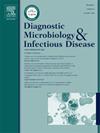Evaluation of loop mediated isothermal amplification, quantitative real-time PCR, conventional PCR methods for identifying Ascaris lumbricoides in human stool samples
IF 2.1
4区 医学
Q3 INFECTIOUS DISEASES
Diagnostic microbiology and infectious disease
Pub Date : 2025-03-20
DOI:10.1016/j.diagmicrobio.2025.116808
引用次数: 0
Abstract
Ascariasis, caused by Ascaris lumbricoides, is a widespread parasitic infection. Traditional diagnostic methods, such as microscopy, can miss infections with low worm burdens, leading to false negatives. This study compares four diagnostic methods—microscopy, conventional PCR, real-time PCR, and loop-mediated isothermal amplification (LAMP)—for detecting A. lumbricoides in 400 stool samples from children aged 2-16. Microscopy methods (direct wet mount, Kato-Katz, and concentration) detected 17, 23, and 21 positive samples, respectively. Molecular techniques identified 23 positive samples by conventional PCR, 29 by real-time PCR, and 25 by LAMP. Notably, real-time PCR detected two samples missed by microscopy, while conventional PCR failed to detect three samples positive by real-time PCR and LAMP. In limit-of-detection assays, conventional PCR detected A. lumbricoides DNA down to 150 pg, while qPCR and LAMP could detect as low as 15 fg. For egg number analysis, conventional PCR detected DNA from 100 eggs, while qPCR and LAMP identified DNA from just 10 eggs. The methods specifically targeted A. lumbricoides, without cross-reacting with other co-occurring parasites. Sensitivity and specificity analysis revealed that microscopy had sensitivities of 81.3 %, while conventional PCR, qPCR, and LAMP had sensitivities of 81.1 %, 99.2 %, and 88.1 %, respectively. Microscopy and conventional PCR had 100 % specificity, while qPCR and LAMP had 99.2 % and 99.9 % specificity. While Kato-Katz is advantageous for detecting active infections, molecular techniques, particularly LAMP's field applicability in resource-limited settings makes it a promising tool for surveillance and control of low-intensity infections.
评价环介导等温扩增、实时定量PCR和传统PCR方法鉴定人粪便中蛔虫的效果
蛔虫病是一种广泛存在的寄生虫感染,由类蛔虫引起。传统的诊断方法,如显微镜检查,可能会漏掉蠕虫负荷较低的感染,从而导致假阴性。本研究比较了显微镜、传统PCR、实时PCR和环介导等温扩增(LAMP)四种诊断方法对400例2-16岁儿童粪便样本中的类蚓蛔虫的检测。显微镜法(直接湿贴片法、Kato-Katz法和浓缩法)分别检测到17、23和21个阳性样本。分子技术鉴定常规PCR阳性23份,实时PCR阳性29份,LAMP阳性25份。值得注意的是,real-time PCR检测到镜检缺失的2个样本,而传统PCR检测不到real-time PCR和LAMP检测阳性的3个样本。在检测限分析中,传统PCR检测到的蚓类DNA低至150 pg,而qPCR和LAMP的检测限低至15 fg。对于卵数分析,传统PCR检测了100个卵的DNA,而qPCR和LAMP仅检测了10个卵的DNA。该方法专门针对蚓状拟虫,与其他共发生寄生虫无交叉反应。灵敏度和特异性分析显示,镜检的灵敏度为81.3%,而传统PCR、qPCR和LAMP的灵敏度分别为81.1%、99.2%和88.1%。镜检和常规PCR的特异性为100%,qPCR和LAMP的特异性分别为99.2%和99.9%。虽然Kato-Katz在检测活动性感染方面具有优势,但分子技术,特别是LAMP在资源有限环境中的现场适用性,使其成为监测和控制低强度感染的有前途的工具。
本文章由计算机程序翻译,如有差异,请以英文原文为准。
求助全文
约1分钟内获得全文
求助全文
来源期刊
CiteScore
5.30
自引率
3.40%
发文量
149
审稿时长
56 days
期刊介绍:
Diagnostic Microbiology and Infectious Disease keeps you informed of the latest developments in clinical microbiology and the diagnosis and treatment of infectious diseases. Packed with rigorously peer-reviewed articles and studies in bacteriology, immunology, immunoserology, infectious diseases, mycology, parasitology, and virology, the journal examines new procedures, unusual cases, controversial issues, and important new literature. Diagnostic Microbiology and Infectious Disease distinguished independent editorial board, consisting of experts from many medical specialties, ensures you extensive and authoritative coverage.

 求助内容:
求助内容: 应助结果提醒方式:
应助结果提醒方式:


